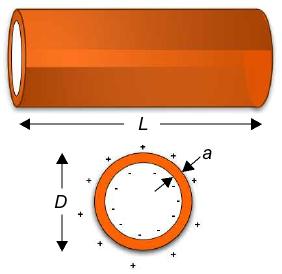8.4.P1
A nerve cell or neuron communicates with other nerve cells through a long "process" (this neuroscience technical term to mean something extended out of a neuron) or cable called an axon. This axon is a long thin tube that is electrically active. A drawing of two neurons connected by one of their axons is shown in the figure below. (From B. Alberts et al., Molecular Biology of the Cell, Fourth Edition: Garland Science 2002, p. 1228.)

The cell membrane of the axon maintains a potential difference of about 70 mV from the inside to the outside of the membrane. It therefore acts as a capacitor. In this problem we will estimate the capacitance of an axon and the electrical energy stored in the resting axon.
|
A. We will model the axon membrane as a long thin cylindrical capacitor of thickness a, diameter D, and length L, as shown in the figure at the right above. It is filled with a fluid having a dielectric constant κ (kappa).
If the membrane is thin compared to the radius of the cylinder, we can approximate the cylinder as a parallel plate capacitor by cutting it along the length and flattening it out. It will then look something like shown in the figure at the right below. (We have used that the circumference of the cylinder is πD.)
Calculate the capacitance of the capacitor in terms of the parameters of its shape and its dielectric constant.
B. The values for the parameters in a typical axon are as follows:
- axon diameter, D ~ 10 μm = 10-5 m
- membrane thickness, a ~ 5 nm = 5 x 10-9 m
- dielectric constant, κ ~ 7.
Calculate the capacitance per unit length of an axon in Farads/m. In addition to getting the value, show that your units work out correctly.
|


|
C. Given the resting voltage difference across the capacitor plates, calculate the amount of electrical energy stored in an axon 1 mm in length.
Joe Redish 3/16/08
Comments (0)
You don't have permission to comment on this page.